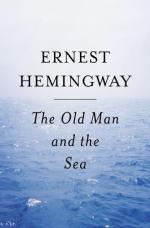|
This section contains 3,249 words (approx. 11 pages at 300 words per page) |

|
SOURCE: "The Old Man and the Sea: A Lacanian Reading," in Hemingway: Essays of Reassessment, Oxford University Press, 1991, pp. 190-99.
In the following excerpt, Stoltzfus presents a semiotic reading, based on the psychoanalytic theories of Jacques Lacan, of the central words in The Old Man and the Sea, which, he contends, provide insight into Hemingway's conscious narrative as well as both Santiago's and Hemingway's unconscious desires.
If the narrative level of The Old Man and the Sea represents the one-eighth of the iceberg above the surface of the sea, what can we find out about the seven-eighths portion of the story that is presumably there but is neither spoken nor visible? In my attempt to define it I will focus on three categories: (1) what Hemingway consciously put into the text; (2) what the reader puts into it in order to generate meaning; and (3) Hemingway's unconscious (desire) which escapes his...
|
This section contains 3,249 words (approx. 11 pages at 300 words per page) |

|


